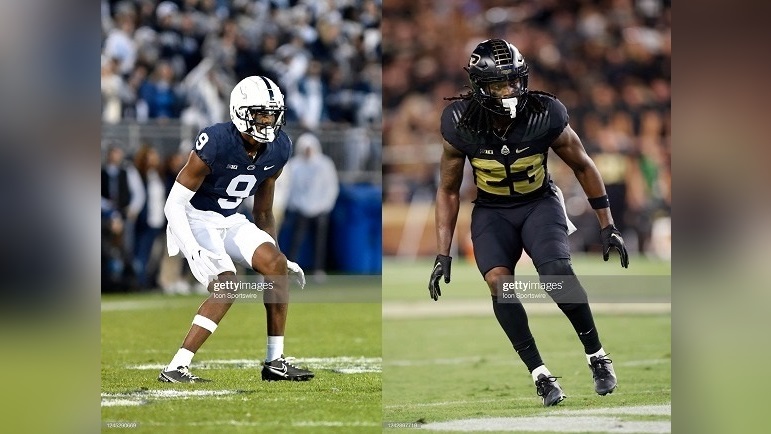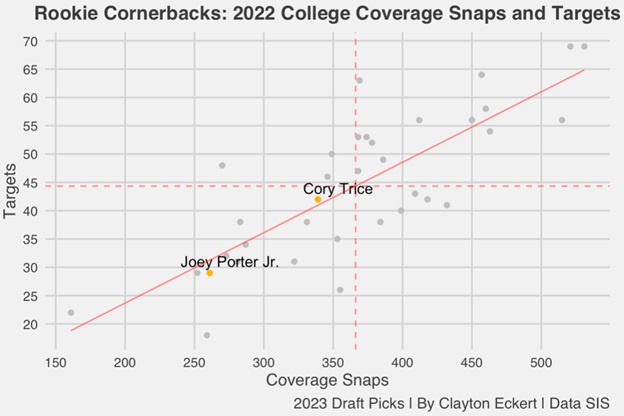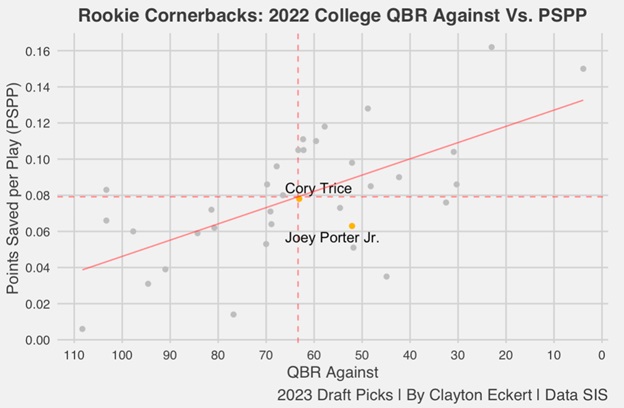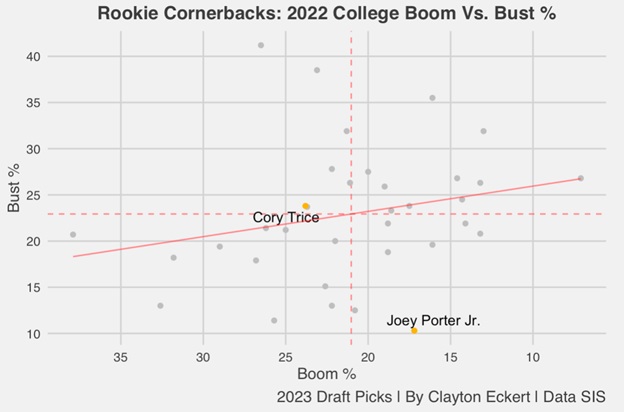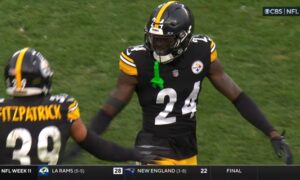Continuing the series, I am moving to the cornerback position, where Pittsburgh was able to select Joey Porter Jr. at 32nd overall, along with Cory Trice Jr. in the seventh round. Today’s goal is to look at and provide stat context for the position using Sports Info Solutions (SIS). The data in this study looks at their final college seasons in 2022, focusing on the players who heard their names called in the draft, and one player was excluded due to SIS not tracking smaller schools. The goal is to see how Porter and Trice stacked up among their peers.
First, let’s look at opportunities with coverage snaps and targets:
Porter lands on the bottom left of the chart, with 261 coverage snaps, which was the fourth least of the 35 qualifying cornerbacks. He started 10 games last season, missing two due to an appendectomy, and was targeted only 29 times (T-fourth least). Some of that was due to less playing time, but thanks to our own Melanie Friedlander’s new entrance physical series, we should expect Porter Jr. to be healthy for offseason practice and hit the ground running at training camp to hopefully earn a starting role. More encouraging context is quarterbacks avoided him after a strong season opener with a whopping six pass break ups on 14 targets (roughly half of his 2022 total targets).
Trice landed closer to the mean but slightly below average in opportunity as well. He had 339 coverage snaps (24th) and was targeted 42 times (T-19th) in 13 starts, which included the conference championship against Michigan. That is encouraging availability considering the medical concerns we heard teams had during the pre-draft process (can’t wait for Friedlander’s report).
Now let’s begin to examine the quality of play further with completion percentage and deserved catch percentage, which is the number of completions and drops divided by the number of catchable targets and passes defensed:
Encouragingly, both Pittsburgh rookie cornerbacks land above the mean in the data points. Porter fared extremely well, with the second ranked deserved catch percentage, highlighting his lockdown corner potential, while ranking 16th in completion percentage. Trice had a slightly better allowed completion percentage for a respectable 12th rank, along with his deserved catch percentage landing at the same spot. Very encouraging results considering all the talented wide receivers in the AFC North and across the NFL.
I was also curious to see the type of coverage schemes the players were in, obviously another important piece of the puzzle. Here are those percentages from PFF:
| PLAYER | MAN% | ZONE% |
| Joey Porter Jr. | 45.1 | 37.5 |
| Cory Trice Jr. | 17.8 | 71 |
While both players played primarily outside corner last year, we see a huge difference in coverage schemes. Porter had a high percentage in man coverage, as expected, but the big takeaway is Trice’s whopping 71% in zone coverage, while in man only 17.8% of the time last season. To put this into further context, the primary cornerbacks for Pittsburgh in 2022 (Cameron Sutton, Levi Wallace) were in man roughly 35% of the time, compared to about 52% in zone. This will indeed be interesting to monitor, to see how Pittsburgh’s rates compare to last season, as we project how the draft picks will fare in the NFL, and important context as we dive deeper today.
Next, let’s look at the depth of targets with yards per attempt and yards per coverage snap:
Here is another aspect of play that Porter fared very well in, tying for second in yards per attempt and snap. This is very impressive given the amount of man coverage he played in, while on the outside often covering the opposition’s best receiver. Trice was below average in these terms, 23rd in yards per attempt and tied for the same rank per snap. Some of this has to do with the high amount of zone he was in, but encouragingly had 22 tackles on coverage snaps with only one missed tackle (4%), per PFF. In comparison, Porter had 17 tackles in these opportunities, with four missed tackles at a much higher rate of 17.4%. Very important as we gauge Trice’s potential role (outside corner or potentially a hybrid slot/safety) if given an opportunity, and each of their strengths/weaknesses from a yards allowed perspective in coverage last season.
Another stat that is often used to evaluate defenders in coverage is QB Rating Against, so let’s see how they fare along with Points Saved Per Play (PSPP), which is the total of a player’s EPA responsibility while in coverage using the Total Points system that distributes credit among all players on the field for a given play (with positive numbers being good). Totals are scaled up to map to the average points scored or allowed on a team level, with the player’s snap count determining how much to adjust. For pass defenders, this includes accounting for pass rush, broken tackles, dropped interceptions, turnovers, and turnover returns. Values are modulated using a quality-of-competition multiplier based on each opponent’s previous year of performance:
Porter had an above average QBR Against that tied for 11th best in 2022, which further highlights some of his strengths previously mentioned. He also impressively did not allow a touchdown last year, which is another feather in his cap that Pittsburgh surely found enticing, considering the improvement needed from last year in this regard. The other side of the coin was a below the mean PSPP ranking 25th. One aspect of this was having no interceptions, along with tackling while in coverage a lower aspect of his season, and here’s to hoping that will improve. Trice lands at the center of the chart, about as close as you can get to average in both data points. He ranked 18th in both regards, with tackling and having two interceptions his stronger marks, but did allow two touchdowns.
To close, let’s look at boom and bust percentages from SIS to see how the cornerbacks performed on extreme end of the spectrum plays:
- Boom % = The percentage of dropbacks that resulted in an Expected Points Added (EPA) of 1 or more (a very successful play for the offense)
- Bust % = The percentage of dropbacks that resulted in an EPA of -1 or less (a very unsuccessful play for the offense)
Porter limited successful offensive plays with a boom percentage that ranked 10th but lacked the high-end variance in game changing turnover/scoring terms, with the worst ranked bust rate. Maybe this was a factor in his perceived fall in the draft, but who better to land with than Steelers defensive back coach Grady Brown and a position room that tied the NFL with the most picks last season. Hopefully Brown can help maximize Porter Jr.’s pass break-up ability and we see him cash in with turnovers. Trice is on the other side of the coin, allowing more big plays from the opposing offense last year, ranking 26th, while landing just above average in playmaking which tied for 21st. Hopefully this can carry over, but the NFL is of course a completely different animal, and I can’t wait to see how it all plays out.
In regards to the data and the outlook for 2023, Porter fared best in yardage allowed and deserved catch percentage, where he was in the top three in this draft class. He earned the respect of opposing offenses that avoided targeting him overall, and was highly utilized in man situations often limiting the oppositions best receiver. He was above average in completion percentage, QBR against, and boom % which is all encouraging as well, while the low marks of his 2022 season were coverage snap opportunities, PSPP, bust rate (lowest ranked draftee), and missed tackles while in coverage.
Trice fared best in deserved and catch percentages, which is extremely encouraging for both players, was a strong tackler in coverage, slightly above average in bust rate, average in QBR Against and PSPP, below average in snaps, targets, yardage allowed, and boom percentage, and is coming off a 2022 season where his high variance of zone and far less man coverage will be interesting to monitor. He does have safety experience, which our own Alex Kozora pointed out as a potential move in the future, or a slot/hybrid option perhaps, which is arguably the most glaring need on the Steelers roster currently. The medical on Trice is an unknown that we’ll have to watch play out, but the talent of both draft picks are attractive. One thing’s for sure, I can’t wait to see how it all plays out for the rookies this year and beyond.
Throughout the rest of the offseason, I will dive deeper into the data as we continue to learn about the newest Pittsburgh Steelers. How do you think Joey Porter Jr. and Cory Trice Jr. will fare their rookie year? If you have any questions on the rest of the drafted cornerbacks across the league, please ask. Thanks for reading and let me know your thoughts in the comments.

